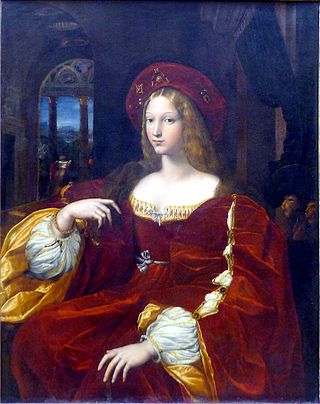
Isabella d'Este was Marchioness of Mantua and one of the leading women of the Italian Renaissance as a major cultural and political figure. She was a patron of the arts as well as a leader of fashion, whose innovative style of dressing was copied by numerous women. The poet Ariosto labeled her as the "liberal and magnanimous Isabella", while author Matteo Bandello described her as having been "supreme among women". Diplomat Niccolò da Correggio went even further by hailing her as "The First Lady of the world".

Giovanni di Niccolò de Luteri, better known as Dosso Dossi, was an Italian Renaissance painter who belonged to the School of Ferrara, painting in a style mainly influenced by Venetian painting, in particular Giorgione and early Titian.

Renée of France, was Duchess of Ferrara from 31 October 1534 until 3 October 1559 by marriage to Ercole II d'Este, grandson of Pope Alexander VI. She was the younger surviving child of Louis XII of France and the duchess regnant Anne of Brittany. In her later life, she became an important supporter of the Protestant Reformation and ally of John Calvin.

Alfonso d'Este was Duke of Ferrara during the time of the War of the League of Cambrai.

Virginia de' Medici was an Italian princess, a member of the House of Medici and by marriage Duchess of Modena and Reggio.

Alfonso II d'Este was Duke of Ferrara from 1559 to 1597. He was a member of the House of Este.

Margherita Barbara Gonzaga, was an Italian noblewoman, Duchess consort of Ferrara, Modena and Reggio between 1579 and 1597 by marriage to Alfonso II d'Este, Duke of Ferrara, Modena and Reggio. She was a significant cultural patron in Ferrara and Modena.
Frederick Hartt (1914–1991) was an Italian Renaissance scholar, author and professor of art history. His books include History of Italian Renaissance Art, Art: A History of Painting, Sculpture, and Architecture (two volumes), Michelangelo , The Sistine Chapel and The Renaissance in Italy and Spain . He was also involved with cataloging and repatriating art work looted and stolen by the Third Reich during World War II.

Barbara of Austria, was an Archduchess of Austria as a member of the House of Habsburg and by marriage Duchess consort of Ferrara, Modena and Reggio during 1565–1572.

Ippolito (I) d'Este was an Italian Roman Catholic cardinal, and Archbishop of Esztergom. He was a member of the ducal House of Este of Ferrara, and was usually referred to as the Cardinal of Ferrara. Though a bishop of five separate dioceses, he was never consecrated a bishop. He spent much of his time supporting the ducal house of Ferrara and negotiating on their behalf with the Pope.

Obizzo II d'Este was Marquis of Ferrara and Ancona.

Ercole I d'Este KG was Duke of Ferrara from 1471 until 1505. He was a member of the House of Este. He was nicknamed North Wind and The Diamond.

Lucrezia de' Medici was a member of the House of Medici and by marriage Duchess consort of Ferrara, Modena and Reggio from 1558–1561.
Giulio d'Este was the illegitimate son of Ercole I d'Este, Duke of Ferrara. He is known for the conflicts he had with his half brother, Ippolito d'Este, which culminated in a failed conspiracy.

The Galleria Estense is an art gallery in the heart of Modena, centred around the collection of the d’Este family: rulers of Modena, Ferrara and Reggio from 1289 to 1796. Located on the top floor of the Palazzo dei Musei, on the St. Augustine square, the museum showcases a vast array of works ranging from fresco and oil painting to marble, polychrome and terracotta sculpture; musical instruments; numismatics; curios and decorative antiques.

Portrait of Laura Dianti is a c. 1520–25 painting by Titian, now held in the H. Kisters Collection at Kreuzlingen. It is signed "TICI/ANVS F." The portrait features Laura Dianti, mistress, and later wife of the Duke of Ferrara Alfonso I d'Este and an African page. She is dressed in a blue dress with her hand placed on the shoulder of her page as he looks up at her. The painting is possibly associated with a portrait of Alfonso I d'Este. It is also controversial in that it was used to contest the legitimacy of the pair's marriage after the duke's death. It traveled through many locations and was initially thought to be one of many copies until a restoration uncovered a signature by Titian.

Sigismondo d' Este was the youngest son of Ercole I d'Este, Duke of Ferrara, and Eleanor of Aragon, daughter of Ferdinand I of Naples.

Portrait of Doña Isabel de Requesens y Enríquez de Cardona-Anglesola is an oil painting dated circa 1518 that was formerly believed to depict Giovanna d'Aragona. It has been variously ascribed to Raphael, Giulio Romano, or the school of Raphael; it is now usually taken to have been executed by Giulio Romano based on a sketch by Raphael and then altered by Raphael. The painting is now in the Louvre Museum in Lens.

The Lovers, Two Lovers or Love Scene is an oil painting by Giulio Romano, originally painted on panel and later transferred to canvas by A Mitrokin in 1834. Since it was poorly stored and kept off public display due to its subject matter until 1920, it has significant damage, including three large breaks in the canvas sealed with coarse plasters on the reverse and other damage to the paint and varnish layer both before and after the transfer It now hangs in the Hermitage Museum.

















